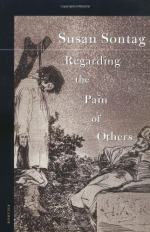
|
| Name: _________________________ | Period: ___________________ |
This test consists of 5 short answer questions, 10 short essay questions, and 1 (of 3) essay topics.
Short Answer Questions
1. Concerned with the public health risk posed by cigarette smoking, officials in which country suggested that images of black lungs, damaged hearts or periodontal disease be included on the warning label for tobacco products?
2. In discussing images that remind us of death, Sontag references a particular 1943 photograph. What is the subject of this photograph?
3. What did Wall's photograph enable soldiers to do that they could not do in "real" life?
4. Sontag claims that the model for public space in modern society is which of the following?
5. Which of the following best describes the "CNN effect" as discussed by Sontag?
Short Essay Questions
1. Sontag contrasts the perceived number of atrocities now with the number from years ago, and makes a specific claim about the rate of atrocity. Discuss this assertion.
2. According to Sontag, why is there no museum dedicated to the victims of the slave trade?
3. Sontag discusses Sebastiao Salgado's series entitled "Migrations: Humanity in Transition" and points out one very problematic effect of the series. Discuss this effect.
4. Discuss the significance of the photograph's intended purpose. If a photograph is intended to convey a message, but because of the context in which it is displayed does not, is the photograph still successful?
5. Ultimately, Sontag notes that to discuss the desensitization of all television viewers is a provincial move, at best. Why does she argue this?
6. Although there are more images broadcast, Sontag suggests that the human response to suffering is relatively unchanged. Discuss Sontag's views on our capacity for dealing with suffering.
7. Why does Sontag refer to the argument that image-glut desensitizes us to images of suffering as "conservative"?
8. In her discussion of the emotional impact of artistic renderings of suffering, Sontag referrs to Kabuki or Bunraku plays. What are these plays? Why does Sontag include this example?
9. Sontag claims that there is a difference between finding beauty in artistic representations of war and finding beauty in photographs of war. What is the difference?
10. Sontag suggests that Wall's work affirms the normalcy of war. How so?
Essay Topics
Write an essay for ONE of the following topics:
Essay Topic 1
Why might a group of people be more sensitive to images of its members in pain? For instance, why might Americans be more sensitive to images of American citizens in pain? Why, do you think, people are less sensitive to the suffering of "others" outside their own social, cultural, or national grouping?
Essay Topic 2
Sontag's book focused, in part, on the ethical or moral ramifications of witnessing war. In particular, she explored the ethics of war representations which capture "full frontal" images of the suffering of others, but almost always shy away from such graphic depictions of the suffering of people like the anticipated audience. Do you agree that this tendency exists in photojournalism? Why or why not?
If you think it does, is there an ethical dilemma inherent in this unbalanced depiction?
If you think it does not, discuss how and why the news media avoid this. Provide examples to counter those Sontag provides.
Essay Topic 3
In her analysis of Woolf's views of war and the business of making war, Sontag elaborated on her contemporary views on gender and its significance to an individual's understanding of war. Do you agree with her gendered assumptions or arguments? Are you more inclined to support Woolf's statement? Why or why not? Be sure to support your argument with contemporary examples and evidence from the text.
|
This section contains 1,238 words (approx. 5 pages at 300 words per page) |

|




